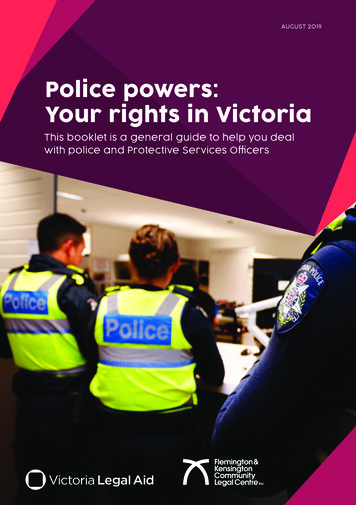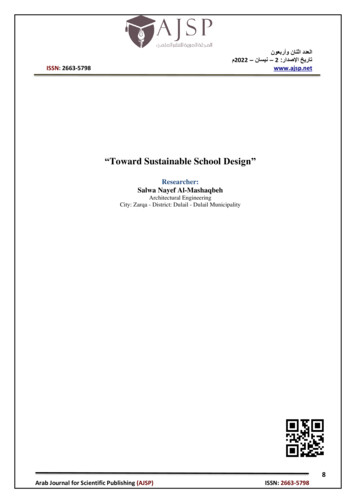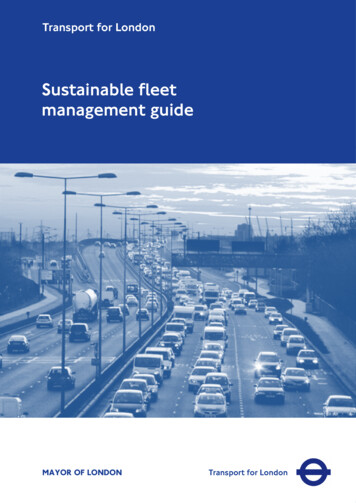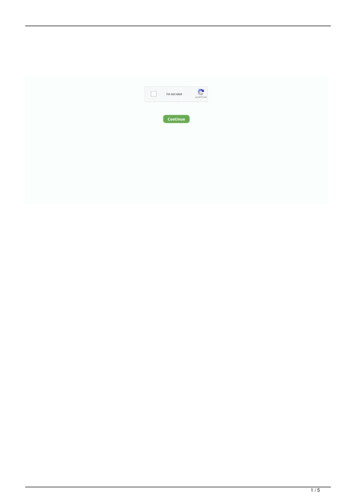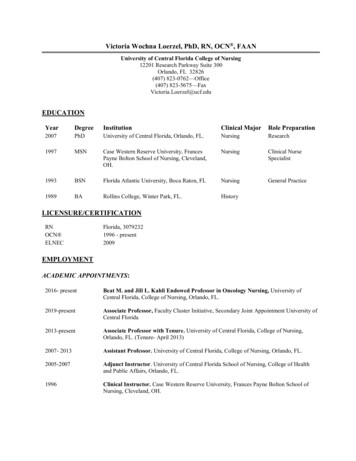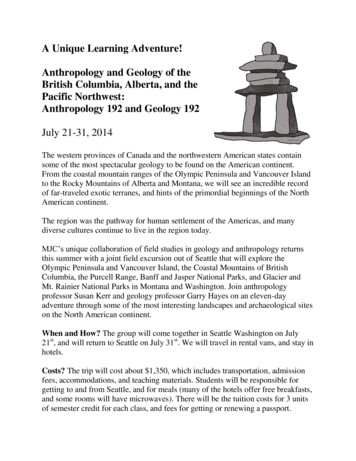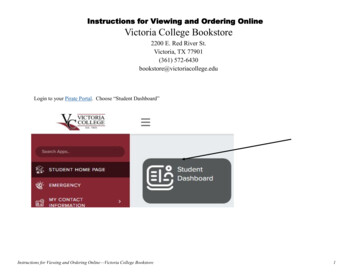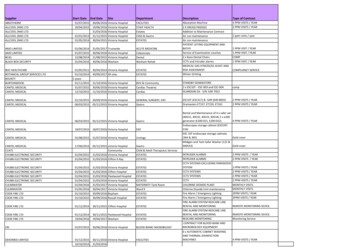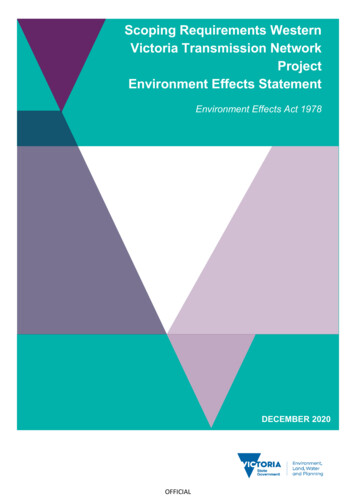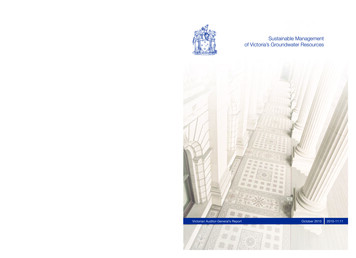
Transcription
Sustainable Management of Victoria’s Groundwater ResourcesSustainable Managementof Victoria’s Groundwater ResourcesOctober 2010Victorian Auditor-General’s ReportTelephone 61 3 8601 7000Facsimile 61 3 8601 7010www.audit.vic.gov.au2010-11:11Level 2435 Collins StreetMelbourne Vic. 3000October 20102010-11:11
ent ofVictoria’s GroundwaterResourcesOrdered to be printedVICTORIANGOVERNMENT PRINTEROctober 2010PP No 380, Session 2006–10
This report has been produced to ISO14001 environmental standards. It is printed on FSC credited Novatech Satin & MediaPrint Silk paper. The print supplier, Blue Star PRINT has initiated an EMS promoting minimisation of envirthe deployment of efficient technology, rigorous quality management procedures and a philosophy of reduce, rISBN 978 1 921650 55 0
The Hon. Robert Smith MLCPresidentLegislative CouncilParliament HouseMelbourneThe Hon. Jenny Lindell MPSpeakerLegislative AssemblyParliament HouseMelbourneDear Presiding OfficersUnder the provisions of section 16AB of the Audit Act 1994, I transmit my performancereport on Sustainable Management of Victoria’s Groundwater Resources.Yours faithfullyD D R PEARSONAuditor-General5 October 2010Victorian Auditor-General’s ReportSustainable Management of Victoria’s Groundwater Resourcesiii
ContentsAudit summary.viiBackground. viiAudit objective . viiConclusions . viiFindings . viiiRecommendations .ixSubmissions and comments received .x1. Background .11.1Groundwater. 11.2Water policy and legislation. 11.3Groundwater access and management . 21.4Groundwater use and monitoring . 31.5Audit objective and scope . 52. Groundwater planning .72.1Introduction. 82.2Conclusion. 82.3Groundwater data. 82.4Groundwater planning . 123. Managing groundwater use .173.1Introduction. 183.2Conclusion. 183.3Groundwater licensing and metering. 183.4Monitoring compliance with licence conditions. 20Appendix A. Audit Act 1994 section 16—submissions and comments.23Victorian Auditor-General’s ReportSustainable Management of Victoria’s Groundwater Resourcesv
Audit summaryBackgroundGroundwater is water that seeps from the surface into porous sands, silts andfractured rocks. Like the surface water in rivers, lakes and dams, it is a finite resource.When rain or snow falls on land some of it evaporates, gets absorbed by plants, flowsinto streams and rivers, and seeps into the soil. Surface water that seeps intounderground spaces ‘recharges’ groundwater.Groundwater is used as drinking water in more than 80 cities and towns, for cropirrigation, stock, dairy cleaning, and for domestic gardening and cleaning. Irrigators,domestic and stock users, and urban dwellers rely more on groundwater duringdrought.Audit objectiveThis audit examined whether the use of groundwater resources is sustainable.Specifically, it examined whether water planners and managers use relevant andreliable information to manage the access to, and license the use of, groundwater. Italso assessed the effectiveness of licence monitoring and enforcement activities.ConclusionsThe Department of Sustainability and Environment (DSE) and water corporations donot know whether groundwater use is sustainable. While a robust planning frameworkand planning tools have been developed, their effectiveness is undermined byinadequate groundwater data and monitoring, and delayed development andimplementation of management tools.Licensing, metering and compliance monitoring activities are not rigorous enough toassure DSE or water corporations about who extracts groundwater and how much theyextract. There is also insufficient data about groundwater reserves and sustainableextraction rates.Victorian Auditor-General’s ReportSustainable Management of Victoria’s Groundwater Resourcesvii
Audit summaryFindingsGroundwater planningThe State Observation Bore Network (SOBN) is the main source of groundwaterinformation, comprising around 2 500 groundwater bores. However, it cannot, bydesign, provide DSE or water corporations adequate information about groundwaterstocks, extraction and recharge rates, or the interconnection between ground andsurface water. Data gaps and the uncertainty about groundwater quality mean thatDSE and water corporations cannot effectively monitor, plan and manage Victoria’sgroundwater resources.DSE has recognised limitations with the SOBN. It has commenced a refurbishmentprogram, replacing bores at, or near, the end of their useful life. The program also aimsto improve bore network coverage in areas not currently or adequately monitored.DSE’s strategic planning is underpinned by a range of planning tools, includingresource appraisals, management plans and rules and sustainable water strategies.Resource appraisals are providing DSE and water corporations with detailedinformation about groundwater to assist with sustainable management. However,management plans have not been developed and implemented for all extensively usedaquifers as intended. This is in part due to what water corporations consider anunnecessarily slow and expensive process.While other tools are in place to manage extractions, the absence of managementplans increases the prospect of unsustainable use. Local management rules are inplace for six groundwater management areas and one irrigation area. These rules areeasier to implement than management plans, and there is greater opportunity for watercorporations to use these more often and as an alternative to management plans.Groundwater managementThe sustainable use of groundwater depends on sound management practices. Giventhe increasing demand for this resource, management practices limiting access to, andextraction of, groundwater are vital. Effective monitoring is also needed, to assure thataccess and extraction conditions are met.The licensing and metering regime for groundwater continues to evolve and improve,but there are several limitations around unlicensed users and bores. Uncertainty aboutthe number of the unlicensed users and bores, and the inconsistency of meteringpractices, reduce the regime’s effectiveness.Metering groundwater extractions is crucial in managing sustainable groundwater use.It tells planners and managers how much water users are extracting and whether theyare complying with the extraction limits of their licences. Despite progress in meteringgroundwater users, many remain unmetered, limiting the usefulness of metering as animportant data source.viiiSustainable Management of Victoria’s Groundwater ResourcesVictorian Auditor-General’s Report
Audit summaryMeter readings are the main source of compliance activity. Without more robustcompliance monitoring and enforcement activities, it is unlikely that non-compliancewill be detected or The Department of Sustainability and Environment should: reconcile its State Observation Bore Network programpriorities with available resources to clarify whetherrefurbishment can occur in a reasonable time frame update its sustainable water strategies to reflect thelonger-term significance of groundwater and itssustainable management, incorporating climate changeeffects and the connections between ground andsurface waters.162.Water corporations should develop and implementgroundwater management plans, or apply localmanagement rules, where appropriate, for all extensivelyused aquifers.163.The Department of Sustainability and Environment andwater corporations should:22 obtain up-to-date and reliable information on thenumber of groundwater bores, particularly for domesticand stock users develop strategies to better understand domestic andstock groundwater use and manage its impact ongroundwater systems.4.Water corporations should develop sound risk-basedcompliance monitoring to detect and deternon-compliance.225.Goulburn-Murray Water and Grampians Wimmera MalleeWater should develop sound enforcement frameworks tomanage non-compliance.22Victorian Auditor-General’s ReportSustainable Management of Victoria’s Groundwater Resourcesix
Audit summarySubmissions and comments receivedIn addition to progressive engagement during the course of the audit, in accordancewith section 16(3) of the Audit Act 1994, a copy of this report was provided to theDepartment of Sustainability and Environment, Goulburn-Murray Water, SouthernRural Water and Grampians Wimmera Mallee Water, with a request for submissions orcomments.Agency views have been considered in reaching our audit conclusions and arerepresented to the extent relevant and warranted in preparing this report. Their fullsection 16(3) submissions and comments, however, are included in Appendix A.xSustainable Management of Victoria’s Groundwater ResourcesVictorian Auditor-General’s Report
1Background1.1GroundwaterGroundwater is water that seeps from the surface into porous sands, silts andfractured rocks. It collects in underground spaces that range from immense floodedsand beds to small fractures in rock layers. Like the surface water of rivers, lakes anddams, it is a finite resource.Aquifers are underground spaces that hold water reserves, which vary in depth, qualityand quantity, and in how they connect with surface water. Aquifer reserves depletequickly if the rate of water extraction is faster than inflows from seeping surface water.Groundwater systems with high extraction rates need careful management.This audit examines whether using groundwater from aquifers is sustainable.According to the National Water Initiative, a sustainable yield is ‘the level of waterextraction from a particular system which, if exceeded would compromise keyenvironmental assets, or ecosystem functions and the productive base of theresource’.1.2Water policy and legislationOur Water Our FutureOur Water Our Future is Victoria’s strategy for managing water resources, includinggroundwater. It assesses future supply challenges and outlines policies for dealing withthem, including groundwater.Sustainable water strategiesSustainable water strategies are 50-year regional plans that aim to secure water forcommunity use, while balancing environmental concerns. The Department ofSustainability and Environment (DSE) has developed strategies for the Central andNorthern regions, and a draft strategy for the Western region. These strategies providefurther policy direction for groundwater management.Victorian Auditor-General’s ReportSustainable Management of Victoria's Groundwater Resources1
BackgroundNational Water InitiativeAll state governments signed the National Water Initiative (NWI), an agreement onwater reform. It aims to create a soundly regulated national water market, and planningfor managing rural and urban use of surface and groundwater.Each state and territory government is preparing an NWI implementation plan. Victoriahas lodged a plan to protect and repair stressed rivers and groundwater systems, andto improve monitoring and reporting on the quantity and quality of the state’s waterresources.The National Water Commission, which advises the Council of Australian Governmentsand the Australian Government on national water issues, has accredited Victoria’splan.The Water Act 1989Under the Water Act 1989 (the Act) responsibility for managing groundwater rests withthe Crown through the Minister for Water. DSE reports to the minister and isresponsible for water through its Groundwater and Licensing Branch.The minister delegates the administrative and operational management of ruralgroundwater to Goulburn-Murray Water, Grampians Wimmera Mallee Water andSouthern Rural Water. Southern Rural Water is also delegated responsibility formetropolitan groundwater.1.3Groundwater access and management1.3.1 LicencesThe Act regulates the management of groundwater extraction. While landowners canextract groundwater as a matter of right for domestic and stock use, irrigators andcommercial users must get a ‘take and use’ licence. However, all users need boreconstruction licences, aimed at minimising environmental impact.Water corporations issue ‘take and use’ licences, valid for between one and 15 years,with conditions that specify the place, rate and annual volume of groundwaterextraction.1.3.2 Extraction managementWater corporations manage groundwater extraction from aquifers in geographicalareas known as groundwater management units. There are three types ofmanagement units: Water supply protection areas—areas where there are heavily usedgroundwater systems. They are subject to intensive management throughgroundwater management plans.2Sustainable Management of Victoria's Groundwater ResourcesVictorian Auditor-General’s Report
Background Groundwater management areas—areas where groundwater systems havebeen intensively developed or have the potential to become more highly used.These areas may need a high level of management in the future. All groundwatermanagement areas are subject to water entitlement caps and some are managedthrough management rules developed and approved by water corporations.Unincorporated areas—groundwater systems where there has been limiteddevelopment or use of groundwater. This is usually because the system is lowyielding, the water quality is poor and has limited use, or there is limitedinformation about resource availability.There are 62 geographic groundwater management units covering 100 per cent of thestate’s total groundwater allocations. In all water supply protection areas andgroundwater management areas, the volume of groundwater for extraction has apermissible consumptive volume (PCV). This acts as a cap on the licensed entitlementissued for an area. Water corporations cannot issue new licences if the PCV has beenreached or is likely to be breached. If a user needs more water than the licensedvolume, they can only get it by permanently or temporarily obtaining a transferredentitlement from another licensed user.1.4Groundwater use and monitoring1.4.1 Groundwater useGroundwater is widely used in more than 80 cities and towns. Uses include cropirrigation, stock watering, dairy cleaning, domestic gardening and cleaning. Towns alsouse groundwater for drinking where it has been treated. Irrigators, domestic and stockusers and urban dwellers have relied more heavily on groundwater during the drought.Figure 1A shows that groundwater entitlements and use have risen over the five yearsto 2008–09, peaking in 2006–07. This coincided with some of the lowest rainfall onrecord. Figure 1B shows the comparison between groundwater and surface water use,and the increased reliance on groundwater as the availability of surface waterdiminished.Victorian Auditor-General’s ReportSustainable Management of Victoria's Groundwater Resources3
BackgroundFigure 1AGroundwater licensed entitlement and use1 200 000Megalitres1 000 000800 000600 000400 000200 00002003–042004–052005–062006–07Total groundwater entitlements2007–082008–09Total useSource: Victorian Auditor-General's Office, based on Department of Sustainability andEnvironment information.6 000 000600 0005 000 000500 0004 000 000400 0003 000 000300 0002 000 000200 0001 000 000100 0000Groundwater use (megalitres)Surface water use (megalitres)Figure 1BComparison of ground and surface water use02003–042004–052005–06Total surface water2006–072007–082008–09Total groundwater useSource: Victorian Auditor-General's Office, based on Department of Sustainability andEnvironment information.4Sustainable Management of Victoria's Groundwater ResourcesVictorian Auditor-General’s Report
Background1.4.2 Monitoring groundwater useThe State Observation Bore Network comprises around 2 500 bores that monitor theavailability and quality of groundwater, and the links between groundwater and surfacewater systems. Monitoring can also provide water resource managers with informationabout the location of groundwater systems, and how extensive they are.1.5Audit objective and scopeThe audit examined whether the use of groundwater resources is sustainable.Specifically, it examined whether: water corporations and DSE use relevant and reliable information to manage theaccess to, and license the use of, groundwater licence monitoring and enforcement activities are effective.The audit alsoexamined the planning, monitoring, licensing and compliance processesfor managing groundwater in rural Victoria.The audit was performed in accordance with the Australian Auditing and AssuranceStandards. The cost of this report was 315 000.Victorian Auditor-General’s ReportSustainable Management of Victoria's Groundwater Resources5
2Groundwater planningAt a glanceBackgroundGroundwater resources are finite and increasingly under pressure. The sustainability ofthe resource is dependent on effective planning.ConclusionThe Department of Sustainability and Environment (DSE) and water corporations arenot yet adequately planning for sustainable groundwater use, due to inadequate dataand delayed implementation of planning tools.Findings Gaps in the quality, comprehensiveness and accessibility of groundwater datalimit its usefulness in planning and management.DSE has recognised the limitations of its bore network and is in the process ofupgrading it.DSE has a sound groundwater planning framework. However, delayedimplementation of specific management plans has hindered the effort tosustainably manage groundwater in high-risk areas.Recommendations The Department of Sustainability and Environment should: reconcile its State Observation Bore Network program priorities with availableresources to clarify whether refurbishment can occur in a reasonable timeframe update its sustainable water strategies to reflect the longer-term significanceof groundwater and its sustainable management, incorporating climatechange effects and the connections between ground and surface waters.Water corporations should develop and implement groundwater managementplans, or apply local management rules, where appropriate, for all extensivelyused aquifers.Victorian Auditor-General’s ReportSustainable Management of Victoria's Groundwater Resources7
Groundwater planning2.1IntroductionVictoria’s groundwater is finite and increasingly under pressure. Its sustainability isdependent on effective planning and adaptive management. This requires managingthe groundwater system on the available information, monitoring the responses of thegroundwater system and then refining management actions based on the observedoutcomes.2.2ConclusionThe Department of Sustainability and Environment (DSE) and water corporations arenot yet adequately planning for sustainable groundwater use. Although improving,planning continues to be hampered by inadequate groundwater data. Effectiveplanning tools have been developed and are used to manage groundwater stocks, butdelayed implementation of some of these tools has increased the prospect thatgroundwater systems in high-risk areas will become unsustainable.2.3Groundwater dataThose planning and managing the sustainable use of groundwater need data on the: location of groundwater systems current water levels extraction and recharge rates connections between groundwater and surface water systems.DSE and the water authorities collect groundwater data for their own activities.Although in some parts of Victoria there is a long history of groundwater managementinformation, this information is neither complete nor sufficiently comprehensivebecause of the significant complexity and cost associated with data collection. Thesedata limitations hinder planning and management.2.3.1 State Observation Bore NetworkEstablished in the 1950s, the State Observation Bore Network (SOBN) is the mainsource of groundwater data. Significant increases in the number of observation boresoccurred throughout the 1960’s and 1970’s and SOBN has continued to grow. SOBNnow comprises around 2 500 groundwater bores that DSE relies on, through quarterlymonitoring, to measure groundwater levels and quality, as part of the StateGroundwater Monitoring Program. SOBN cannot, by design, measure total watervolumes, extraction and groundwater recharge rates in all aquifers. Other tools,including resource appraisals and metered data—where available—provide thisinformation.8Sustainable Management of Victoria's Groundwater ResourcesVictorian Auditor-General’s Report
Groundwater planningOver half the monitoring bores in groundwater management units provide DSE withadequate coverage to inform itself about groundwater levels, and the impact thatextractions have on them. However, around 43 per cent of groundwater managementunits have inadequate or limited SOBN coverage. While this represents a nearly10 per cent improvement since 2009, the lack of coverage continues to limit DSE’sunderstanding of groundwater systems.In addition to SOBN coverage, the condition of bores is also problematic. Around55 per cent of groundwater management units have key bores that are at risk offailure, in part due to their age. Consequently, understanding Victoria’s groundwatersystem will improve with the staged upgrade and refurbishment of SOBN.Figures 2A and 2B summarise DSE’s rating of SOBN coverage and condition by area,as at August 2010.Figure 2ACoverage of the State Observation Bore 123101017138Proposed groundwatermanagement areas00202Unincorporated areas825116191542379Water supplyprotection areasGroundwatermanagement areasTotalNote: Department of Sustainability and Environment descriptions:Inadequate—insufficient bores (number or distribution) to provide meaningful data.Limited—some bores, providing local data, but insufficient for a reasonable aquifer-wideassessment.Adequate—sufficient bores to provide representative aquifer-wide data.Excessive—number of bores exceeds the needs of a baseline monitoring network.Source: Victorian Auditor-General’s Office, using Department of Sustainability andEnvironment data.Victorian Auditor-General’s ReportSustainable Management of Victoria's Groundwater Resources9
Groundwater planningFigure 2BAsset decline/risk of the State Observation Bore NetworkHighMediumLowTotalWater supply protectionareas410923Groundwater managementareas1201738Proposed groundwatermanagement areas0112Unincorporated areas26816Total7373579Note: Department of Sustainability and Environment descriptions:High risk—at or beyond end of life and/or artesian (also includes bores that have failedwhose data is crucial for management).Medium risk—some bores are over 15 years old (non-PVC)—non-artesian.Low risk—less than 15 years old, artesian or non-artesian.Source: Victorian Auditor-General’s Office, using Department of Sustainability andEnvironment data.The data shows that: Out of the 23 water supply protection areas, 18 (78 per cent) have adequateSOBN coverage. The other five (22 per cent) have either limited, inadequate orexcessive coverage. Fourteen of the water supply protection areas (61 per cent)have key bores that are either nearing, at the end of, or past their useful life span. For the 38 groundwater management areas, 17 (45 per cent) have adequateSOBN coverage. The other 21 (55 per cent) have either limited, inadequate orexcessive coverage. Also, around 55 per cent of groundwater management areashave key bores that are near, at the end of, or past their useful lives. Of the 16 remaining unincorporated areas, five (31 per cent) have adequateSOBN coverage. The other 11 (69 per cent) have either limited, inadequate orexcessive coverage. Around 50 per cent of the unincorporated areas have keybores that are either near, at the end of, or past their useful lives.DSE has recognised SOBN limitations, and has spent 10.6 million to upgrade andmaintain SOBN between 2006 and 2010, using a risk-based approach, concentratingon water supply protection areas and groundwater management areas. As atAugust 2010: 182 new bores had been developed, and 45 bores have been decommissioned 113 new bores, and 10 bores for refurbishment or decommissioning had beenapproved and funded, but were not completed.In addition, DSE has identified the need for a further 92 bores and refurbishment of129 bores on sites that they have approved, as well as 344 new bores on sites theyare yet to approve. These works are currently unfunded.10Sustainable Management of Victoria's Groundwater ResourcesVictorian Auditor-General’s Report
Groundwater planning2.3.2 Other groundwater dataWater corporations also monitor the SOBN as part of the local management ofgroundwater. This usually happens monthly at selected bores in water supplyprotection areas and groundwater management areas, as specified by the watercorporations. They collect information about water levels and in some cases aboutwater quality.The water corporations report on groundwater extraction, allocation and useinformation for the three groundwater management unit types—groundwatermanagement areas, water supply protection areas and unincorporated areas. Themost reliable and up-to-date information is on water supply protection areas, followedby groundwater management areas and unincorporated areas. In unincorporatedareas, the level of groundwater use and risk to the resource is low, reducing the needfor more intense management or monitoring.Figure 2C outlines the information systems that store the monitoring data and theirpurposes.Figure 2CGroundwater information systemsInformation systemOwnerFocusVictorian ResourcesData WarehouseDepartment of Sustainabilityand EnvironmentGroundwater monitoringinformationGroundwaterManagement InventoryDepartment of Sustainabilityand EnvironmentGraphics and text on groundwatermanagement unitsThe State WaterRegisterThe Water RegistrarThe public register of all waterentitlements. Also used to issuebore construction and ‘take anduse’ licencesGroundwaterManagement SystemWater corporationsAn internal system for watercorporations and their contractorswith groundwater monitoring andlicensing informationBore CompletionReport SystemDepartment of Sustainabilityand EnvironmentLogs bore and water qualitycharacteristics at the time ofdrilling. Linked to the waterregister to confirm the bore isactiveSOBN managementdatabaseDepartment of Sustainabilityand EnvironmentThe SOBN and its major worksprogramsDryland SalinityMeasurementsDepartment of PrimaryIndustriesDryland salinity boresUtility Services websiteWater corporationsHolds and displays groundwaterdata in real time for DSE, watercorporations and catchmentmanagement authoritiesGroundwaterInfrastructureManagement SystemDepartment of Sustainabilityand EnvironmentAsset management system thatrecords SOBN and monitoringinstrumentsSource: Victorian Auditor-General's Office.Victorian Auditor-General’s ReportSustainable Management of Victoria's Groundwater Resources11
Groundwater planningDifferent agencies, or groups within agencies, manage the various groundwaterinformation systems and databases. The lack of consolidated and centralised dataimpedes the roles of groundwater planners and managers, as well as the integrationbetween information and reporting systems. This has also limited how effectively DSE,water corporations and other groundwater stakeholders can plan and manage theresource.To address these issues, DSE has developed project specifications, which haverecently gone to tender. The water measurement information system aims to offer acentral point of access to water measurement information. Anticipated benefits fromthe water measurement information system include: streamlining the information and data systems making the current systems simpler and more useful meeting increasing demand for water measurement information for future policyand planning assuring compliance with legislative and business requirements.2.4Groundwater planningGiven the prolonged drought and the likely impacts of climate change on surfacewater, water users are increasingly drawing on groundwater. As groundwater is finite,DSE and water corporations have to plan for the long-term to make sure it i
Groundwater systems with high extraction rates need careful management. This audit examines whether using groundwater from aquifers is sustainable. According to the National Water Initiative, a sustainable yield is 'the level of water extraction from a particular system which, if exceeded would compromise key

